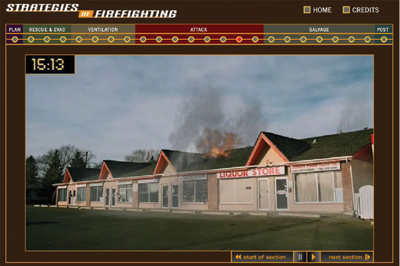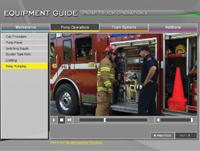
Equipment
E-learning enthusiasts
The idea of using a computer as part of firefighting training was initially met with eye-rolling and statements such as, “It will never work.” This was not the warm welcome needed to incorporate change when e-learning was first proposed at Edmonton Fire Rescue Services (EFRS) in the early part of the new millennium.
February 8, 2011
By Ellen Whybrow
The idea of using a computer as part of firefighting training was initially met with eye-rolling and statements such as, “It will never work.” This was not the warm welcome needed to incorporate change when e-learning was first proposed at Edmonton Fire Rescue Services (EFRS) in the early part of the new millennium. Fire fighting is a physical occupation, so how does e-learning fit in when the training is hands-on?
But change was needed. Everyone in the fire service is aware of the cost and scheduling challenges associated with increased training demands in a post-9/11 world. To overcome these barriers, EFRS identified the use of Internet technology and a learning management system (LMS) as a strategy to provide theoretical content and testing online. This would reduce time spent in a classroom and focus training events on practical applications. Half a decade later, EFRS is on track to recoup its entire initial investment with a program that has saved dollars while increasing practical training time.
 |
| Figure 1: An online depiction of an incident that posed a challenge because of building construction and ventilation strategies worked well as firefighters were able to review the incident and decision-making points relevant to tactical priorities. Photo courtesy Edmonton Fire Rescue Services |
The process
To start, EFRS undertook a year-long process to select an LMS. The selection process included a request for proposal with 33 mandatory and 46 discretionary requirements. A blind review of the proposals between two teams narrowed 13 initial respondents down to two. These two companies went head–to-head in proof-of-concept testing, consisting of a series of interviews, a thorough product review and pilot testing of the products. In the end, EFRS chose Desire2Learn, a Canadian company from Kitchener-Waterloo, Ont.
Strategies
Having great technical tools is just part of this kind of project. There was already a big barrier looming over the project; many Edmonton firefighters were concerned that Internet training would replace critical practical training events. To ensure this project had staying power, EFRS focused on four key strategies:
1. Use of project champions: While e-learning as a concept was championed by management, the success of the project had to be determined by firefighters themselves. Will they use the resources and will they like them?
To ensure firefighters’ comfort with technology, a call went out to the operations staff asking for participation in what was called an LMS support team. This consisted of eight to 10 firefighters, mostly younger staff members, who participated in training sessions covering basic technical and navigational procedures. The team then took this knowledge to fire stations throughout Edmonton. The early sessions were focused on familiarizing senior captains, who were mostly older fire rescue staff and generally less familiar with digital technologies. These sessions were later expanded to include all operational staff.
The use of project champions also included the selection of well-respected firefighters from the floor on course development projects. Their involvement provided a level of credibility to the projects and an internal stamp of approval.
“I worked as a technical advisor,” says station Capt. Dennis Hushagen. “It helped to make sure that we were concentrating on issues that were of interest to the guys. I had an opportunity to assist in identifying things that were more important or needed to be highlighted better (like safety issues) . . . And the best part of the whole thing was I got to be a movie director.”
 |
|
| Figure 2: Desire2Learn’s fire apparatuses program includes XML flash templates and flash video files accessible through a customized collapsible menu. The menus are organized around themes: maintenance, operation and troubleshooting. Each listing launches a flash video on relevant procedures. Photo courtesy Edmonton Fire Rescue Services |
2. Key resources: The value of technology is not in itself, but whether it is used. Firefighters are obviously interested in fighting fires, particularly those that pose a challenge and danger to themselves or others. One resource was the depiction of an incident that posed a particular challenge due to the building construction and ventilation strategies required. Using a limited amount of video, pictures, a few animations showing fire growth in a contained attic, discussion questions and an audio track of radio communication at an incident, a pseudo-simulation was produced that allowed firefighters to review an incident and decision-making points relevant to tactical priorities.
The care and operation of fire apparatuses is also very important. Apparatuses contain features that are complicated and have great impact from a servicing and response point of view. XML flash templates were used to organize flash video files accessible through a customized collapsible menu. The menus were organized around themes relevant to mechanical equipment: maintenance, operation and troubleshooting. The menu lists are customized to each vehicle. Each listing launches a flash video on relevant procedures. The template can be reused for any vehicle and virtually any piece of equipment.
“I’ve had feedback from people who have used the videos quite readily. I think also that they are programs
that are flexible, so updates can be inserted into them in a quick, timely fashion,” notes Hushagen. “And to get the information out fairly readily to people, just a notice is needed to have people review the programs. It’s a good way to connect.”
3. Meeting needs: It is always important to meet learner needs. Brian Riddel, Edmonton’s hazmat training co-ordinator, expressed an interest in getting information and photos about a close call incident involving a rail car carrying the chemical styrene. From this conversation, a course site devoted to post-incident reviews was generated, allowing the posting of incident summaries. One survey comment from a firefighter notes: “I think the format is done quite well. I usually talk about the post-incident reviews with my crew. The lessons-learned section is particularly good. We have had some questions about these and their conclusions. It is a great way to get informed about what happened at a fire when you have been off last block (shift).”
4. Blending e-learning with practical learning: No one ever learned to fight a fire reading a book or watching a video. “. . . With our job environment, there has to be a practical component,” Riddel notes, “We’re hands-on people.”
 |
One example of how the blend of e-learning and emergency response can work together came from training officers involved in medical education and recertification. The training officers launched a new program with required pre-study materials. All firefighters are asked to complete a pre-study portion with an online exam before a scheduled practical in-service is conducted at each fire hall. “Last year’s recertification came at a very opportune time,” says firefighter Rob Cavell. “We had just finished our recertification online when the medical trainers came to present the latest version of CPR and any changes EFRS would be implementing. The next morning, we were just finishing our daily checks when a 911 call came in and we were dispatched to a 29E cardiac arrest. We arrived on scene first and began the CPR protocols. When EMS arrived, the process was well underway and the transition was seamless. Firefighters will most likely perform CPR many times in their career, but to have the refresher immediately before the call was definitely a bonus.”
Results
Everyone wants to see results. In these days of accountability to the taxpayers, e-learning has shown substantial benefit in just four years with the following results:
- Total training days saved in 2009 alone were 605. Using a formula to calculate costs associated with taking a firefighter off shift and replacing that person ($1,334.03/day), cost avoidance1 for the year was $807,087, of which $128,067 was direct cost savings.
- Cumulative cost avoidance from 2006 to the end of 2009 was $1,499,972. Based on these data, the city will recoup its investment in the project by the end of 2010.
- High satisfaction overall with the library of resources available. Ninety-two to 95 per cent of firefighters agreed that the resources were interesting and that they would use them. EFRS management has supported the project through an increased focus on practical training. “E-learning is augmenting the practical. It can confirm or re-familiarize after the practical,” notes Hushagen. “There are also opportunities for e-learning to be an introduction prior to the practical component.”
Future
After a slow beginning, e-learning is now an important resource within EFRS, and the benefits of e-learning are starting to surface.
“I was kind of a pro-practical, anti-e-learning person. I’ve been changed,” admits Riddel. “I’ve learned a lot . . . Working on certain projects, I do see a lot of value in e-learning. I see a lot of value in having a file system where if you’re looking for certain information, you just log in to a computer . . . So there is a kind of organizational advantage to it as well,” he adds.
The future of e-learning will continue to evolve as new needs emerge and new technologies become available. EFRS is now moving toward an increased emphasis on group learning and post-incident review that will further enhance teamwork and effective practices with the branch. We look forward to the next 10 years and beyond.
Ellen Whybrow has nine years’ experience as an instructional system designer in both academic and training environments.
Print this page